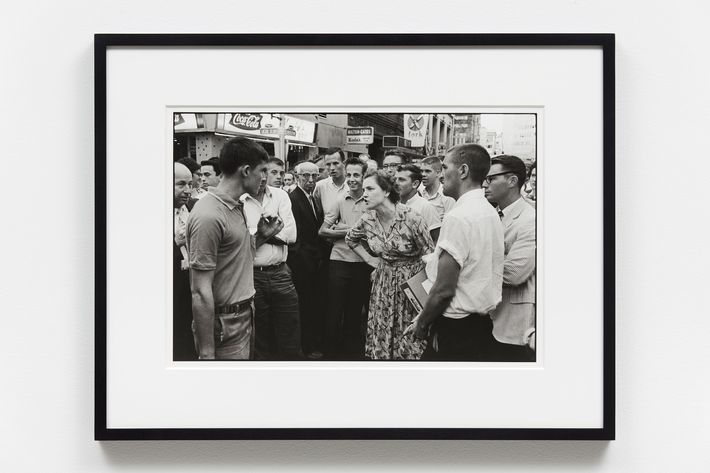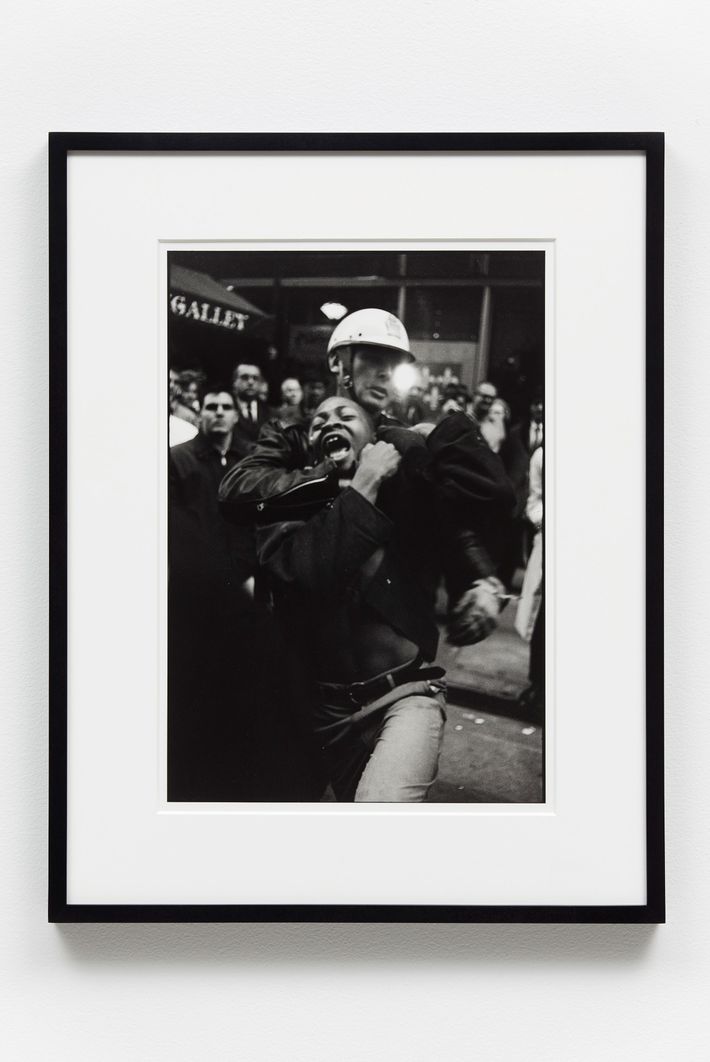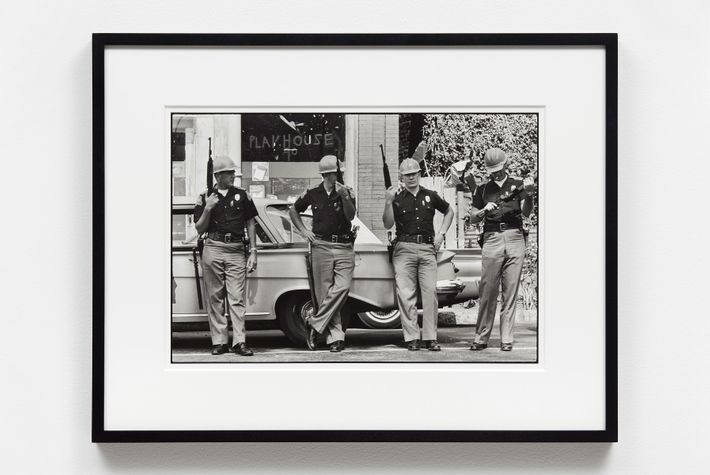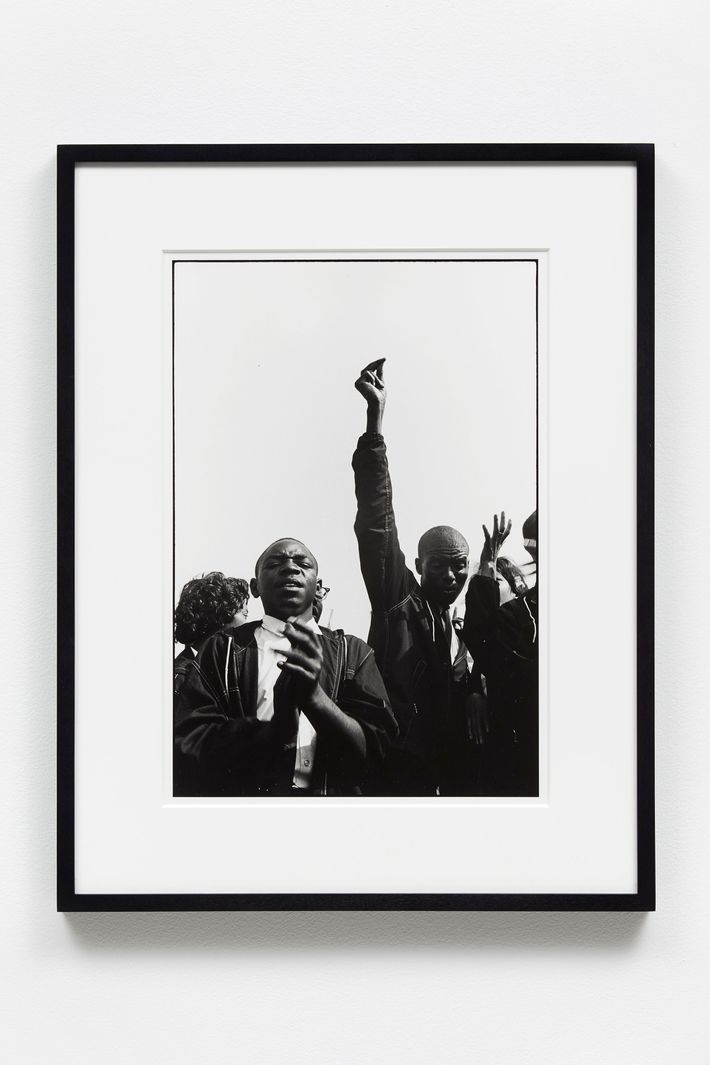
Were there any artists who documented the rise of Trump? His rallies, his voters, his America? The election was a return to history, though liberals were perhaps too sure of themselves to see it at the time: Where is the history painting? Where are all the close-in pictures of fomenting populist rage, racism, nativism, bigotry? As far as I know, no artist captured this. (Or all did in abstract, still indiscernible ways.) All of our visual images have come from two sources, neither that reliable. First, from Trump supporters themselves. (I follow as many as I can: Students for Trump, Women for Trump, etc. But their pictures are all the same: Unironic small groups of happy, waving white people in red MAGA hats.) Second, from the news, whose focus in the end was only on Trump’s behavior and words. And however much he loved the gaze of camera banks at his rallies, Trump was right when he said, panderingly, that the cameras should have been turned away from him; they should have focused on the crowd. Only C-Span showed these crowds in extended unedited pre- and post-speech detail shots. (I do think the crowds we tended to see up close were those of Bernie Sanders.)
So why didn’t any artists rush in to fill the void? First, Trump’s candidacy happened fast; few saw his rise as a void to fill until it was too late. More to the point, by 2015, art, while often topical, mostly took on large, deeply rooted structures like systemic racism, homophobia, sexism, capitalism, or colonialism — except when artists worked on their own issues, usually having to do with aspects of identity and personal history. This often prioritized subject matter and autobiography over visual originality. But artists don’t have to choose, and their work does not have to advocate to be political — or even take “politics” as its subject. Instead, it can choose “injustice,” or “outrage,” “despair,” “community,” “vengeance,” “doom.” That is, the world and all the ways it is perpetually and violently disrupted and disjointed.
But something else happened, by and large during Obama’s presidency. By the end of his eight years, politics had become an outward projection of one’s own position and activism. This narrowed the politics addressed and subtly discouraged critical dissent. If an artwork was supposedly about misogyny but still derivative, simplistic, or just bad, being critical of it could result in being called sexist. Exclusion of art like this from exhibitions or collections could bring accusations of bias. In this way, the art world politically insulated itself while placing itself above its larger audience, often preaching in elaborate formal languages that only the choir knew. But great art did get made. Kara Walker’s gigantic sphinx-like sugar sculpture — which should be resurrected outside the White House — had the terrifying grandeur and malevolence of Moby-Dick, some Last Judgment. When will we see more like it?

One artist whose work was recently on view at Gavin Brown’s Enterprise especially demands attention as an example of that alternate model —especially when it comes to photography. Even with his godsend of a Whitney retrospective last summer, it’s probable that most people have still never heard of one of the most powerful and political photographers in history, Danny Lyon. This is partly because his work couldn’t be more different from what we laud as good photography now — more on that later. Lyon slipped so far off the art-world radar that three years ago, I, a lifelong fan, embarrassed myself asking Lyon’s excellent artist son, Noah, “Is your dad still alive?” Yes, he was, and working nonstop as he always has, now in Bernalillo, New Mexico, where he lives with his wife and dogs. Yet, I hadn’t seen a gallery show of Lyon in decades.
That just changed with the fantastic look back at his pictures from the early 1960s at Gavin Brown last month. Also included was a new video made with his old pal, the late Julian Bond — the two of them discussing how the Occupy Movement didn’t go far enough is fascinating, as is listening to both self-identify as “change agents” and “revolutionaries.” When I met Lyon at his gallery opening, I gleaned he wasn’t man who suffers fools, he never stops moving, and is still on fire. “Where I live is getting militarized,” he told me. “Mexicans have taken the place of black people down there.”

Born in 1942 and raised in Queens (a self-described “white boy from Forest Hills”), in 1962 he took a camera and hitchhiked to Cairo, Illinois, to be part of the civil-rights movement. “The movement became my life,” he told me. “The law was wrong and it was our responsibility to break it.” Sounds familiar. There, he became inspired by and met John Lewis, then chairman of the Student Nonviolent Coordinating Committee (SNCC) and an organizer of the 1963 March on Washington, now a civil-rights hero and congressman, and one of Trump’s continual bête noires. That fall, Lyon was in Mississippi with the movement covering voter registrations. Soon this “white boy from Forest Hills” was SNCC’s “official photographer.” As such, Lyon saw it all, up close, in detail; he covered everyone and everything — sit-ins, riots, prison cells, marchers, mobs, Martin Luther King, Muhammad Ali. He ran from white gangs, hid in cars with guns, escaped police by giving false names at airports (Paul Newman). Yet he was so adroit, that part of our collective inner picture of what this struggle looked like — its bravery, camaraderie, suffering, danger, triumph, and violence — derives from Lyon. The famous One Man One Vote poster of a black man in overalls summed up the movement’s bottom line. Fifteen young black women held in a Georgia stockade, a black choir singing at the March on Washington, mobs turning on demonstrators — all these are Lyon’s pictures. In some ways he sums up what the early political 1960s looked and felt like as much as Jackson Pollock’s drips define what the early cultural 1950s looked and felt like in America.
I saw many of these photographs at the time, like all Americans back then; they were part of our news wallpaper. But I never knew these were Lyon’s pictures until much later; I just thought they were incredible and scary. After this, he recorded the destruction of lower Manhattan as witnessed from his downtown loft. Soon, he was a member of Chicago’s notorious Outlaw motorcycle gang. I grew up around Chicago and these guys were genuine “tough hombres.” By the end of the 1960s, he was photographing Southern chain gangs, which is when I first saw Conversations With the Dead. His book on the subject changed my life.
Like practically everyone of my generation, I was pretty politically active when I was young. In high school I took the subway from my comfy suburb to Grant Park in 1968 where Chicago police began beating us protesters. (It was the night when white kids were beaten rather than people of color that my right-wing Republican stepmother and all her friends turned against the war; in their video, Lyon and Bond rue how the war protests overtook “the movement” at this time. When white kids are beaten, change happens.) But Lyon’s black-and-white close-in images, personal interviews of prisoners, his involvement in the minutia of their lives, showed me that great art and activism could comingle and still retain art’s mysterious ability to make us look at the same picture a thousand times and still have it affect us differently every time. (I still peruse these pictures.) Lyon went on to do this with immigrants at the southern border, and more recently, in China. Fellow geniuses who also took to the streets to make their work included Diane Arbus, Garry Winogrand (my fave), Robert Frank, and the visionary Weegee, as well as photographers like Robert Adams, Lewis Baltz, and Stephen Shore (collectively known as New Topographics — a group that recorded suburbia’s encroachment on the landscape, implicitly showing the rape of the land, the socioeconomics, and white flight that was shaping America). All these artists were as visually and politically radical as any history painting, as stylistically risky as the Impressionists. These artists were models of what I thought photography should be.

But this future was not to be. By the 1970s, after the tumult of the 1960s, America turned inward. So-called political activism and street photography were back-burnered. There was no market for art (the art world hadn’t really formed yet) and so universities were mainly where art was coming from. (And I didn’t go to school.) For the first time in history, almost all artists went to art school. This changed the art world in many ways. First, it gave artists something other than life to push against insofar as most of the teachers were either men, older, or white artists who believed that art was better in the old days of the 1960s. Women in particular were shunted aside, and at the same time, there were implicit prescriptions against painting. (It was dead again.) This meant that just the act of painting itself seemed radical (I remember how shocked I was when I smelled oil paint again in galleries in around 1980!) For women to paint, however, seemed revolutionary. Schools also professionalized the art world, foregrounded careers, galleries, the nascent market, networking.
By the 1980s, these artists, many of them women who found the doors of painting closed to them, took up the camera as a tool and weapon. They made a totally new, powerful activist art. Using images and found objects, they undermined, torpedoed, and coerced new levels of visual recognition from photography, popular culture, advertising, and social structures. Artists like Barbara Kruger, Louise Lawler, Laurie Simmons, and Cindy Sherman, as well as Richard Prince and many others, were warriors who used cameras but whose art had little to do with street or landscape photography, or overt journalism. They weren’t recording the news; they were making it. They flipped the script, making the photograph not be just a recording of reality, but transformed it into a new reality with complex languages of perception. This had been happening in the medium from the beginning, but it exploded in the early 1980s. These artists changed the world as much as Lyon and his generation.
This work was thrilling to me — as thrilling, probably, as the work I had seen by Lyon and others in the 1960s. Though it was politicized in a quite different way: These artists were simultaneously makers, thieves of other people’s images, detectives looking for socio-psycho-cultural clues, curators of subgenres. The artist’s identity was always present in the overt manipulation of these images; the artist was never passive bystander. It’s impossible to look at a Kruger image-text piece and not think “What side am I on?” They still put me on inner notice.
After Pictures Art came a group of artists — almost none of them American, almost all of them men — who drew on the ideas of New Topographics. Only this new group scaled up this vision into huge glitzy pictures, colorized, spectacularized, theatricalized, and theorized them. Artists like Andreas Gursky, Thomas Struth, and Thomas Ruff (so ubiquitous in the 1990s that I collectively called them Struffsky; I got a nasty note from one of them), and Canadians like Jeff Wall and Rodney Graham, all took photography toward movies, billboards, storytelling, history painting, and high-production values. Wall’s gigantic setup aesthetic, with numerous allusions to other art makes him, for me, the best art-history student ever. (Never mind that only art-world denizens know these allusions.) The politics here were seduction so that great systems could be addressed: industrial farming, world trade, museums, architecture, etc. Instead of using the politics of the body, their work was commentary on the then border-to-border, buzzy hum of modern life and what Rem Koolhaas famously called Junk Space.
By 2000, with notable exceptions, the Pictures aesthetic had become so dominant in the art world, so taught in schools, fixed, validated by academics, canonized, collected, and endlessly exhibited in institutions that photography began to ossify and draw in on itself. Moreover, after September 11, 2001, the spectacularization of the Germans and Wall, etc., seemed after the fact. The medium pulled in and essentially became photography about photography. Since then, we’ve seen endless pictures of cameras, photographs of photographs, ads, green screens, commercial photography color cards, mirrors, monochromes, light fixtures, film boxes, film, digital patterns, and even pictures of chemicals used in old-style photography. Also omnipresent are collaged images of other images so that the graphic field is flawed enough for the eye and mind to know that these are familiar signals of setup photography, modernism, postmodernism and, of course, Pictures Art. This art wasn’t looking outward at the world as a subject of messy, wild interest, but only as a source of material the photographer-artist might master, imposing his or her will and vision as fully as a painter might a blank canvas.
Much of this type of work is now rote and formulaic, either ultraformal or nth degree what can you do to the preapproved formats of the monochrome, rectangle, flatness, illusion, found objects, process, materials, etc. This is Zombie Photography. And in the Bush era, believe it or not, I totally understood and embraced some of it. We all got that administration’s message loud and clear: “We don’t give a shit what you think. We make up our own reality.” War and economic collapse were brought on America. So it makes perfect sense that artists turned their backs on this and gathered around their own artistic campfires and commiserated with one another, honing ideas into finer and finer bytes. It was an act of defiance, albeit comprehensible only those in the know. But we badly needed to be cloaked then, developing our languages and looks.
But Trump is different from Bush. This is history of a type we haven’t experienced since the civil-rights and Vietnam War era, and the AIDS crisis in the 1980s. This is big history. Everyone feels the urgency — things are invading us fast, fracturing us. New questions are in the air: big questions, important ones, a rebirth of tragedy maybe. Agglomerations of seriousness are gathering; inner excitements, doubts, ideas are tumbling. This is what a test of time feels like. And the government isn’t prepared to address any of this.
My favorite scene in Apocalypse Now is when the Martin Sheen character asks a soldier in a firefight, “Do you know who’s in charge here?” The terrified soldier pleads, “I thought you were!” Next he asks another soldier the same question and he calmly replies, “Yes.” Meaning we are in charge. This moment gives agency. The situation has fallen once again to us to take matters into our own hands. No one is currently a spectator to any of this. We’re in it. Individuality and the group mind are mingling in new ways. This is why we mustn’t become art police, demanding that art “be political.” All art is political because within every contemporary artist is the deep content of this time and all of that is in their work — even if it’s just stripes or squiggles, done unoriginally, in a fever, with insight. Art, in other words, is going through the same changes you are, that we all are. Last week I saw a great protest sign — Cary Smith’s stark blue, geometric abstract painting that seemed to say, “Focus on this, motherfuckers.”
Indeed, the energy of the streets is already changing inner consciousness, replacing sheer hopelessness, passive alienation, and business as usual. New generations have already found embodied activisms. None of this is a call for artists to make “political art.” Please, God, save us from the reams of insipid “so-called” political art about to wash over us. As Gerhard Richter said, “You can’t say that art is no good because Mozart didn’t prevent the concentration camps.” This isn’t a call for the end of formalist or conceptual photography, either. Nevertheless, it does seem something is stirring in younger artists that stirred in Lyon long ago. Some of them may hitchhike to the heartland to take pictures of Trump supporters or the new faces of all of us feeling like we’re part of some sort of new countermovement. Either way, for this stain to be erased from America, two things need to happen: First, Republican overreach and failure will lead to protest; second, this energy of the street can make us all “change agents.” America is in the balance again. We need to see what all this looks like without the filters of the news and zealots. We need to see America singing from the point of view of the artist.


